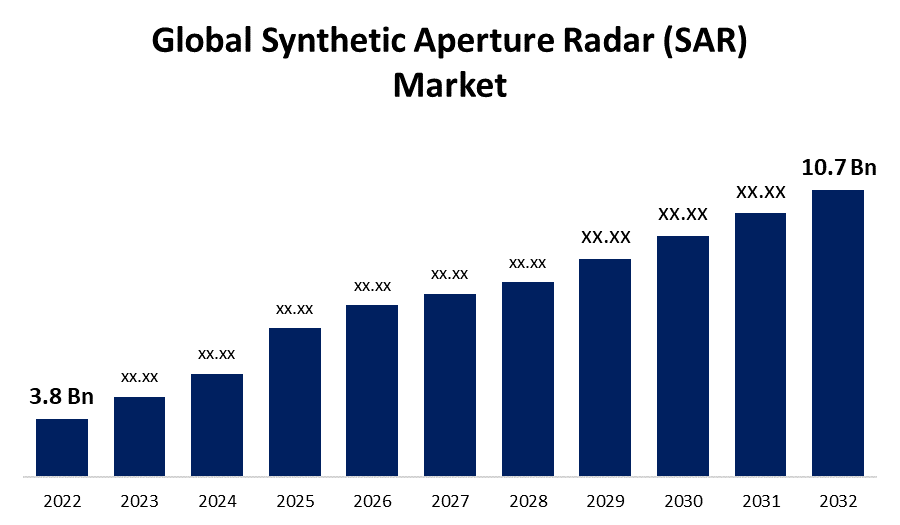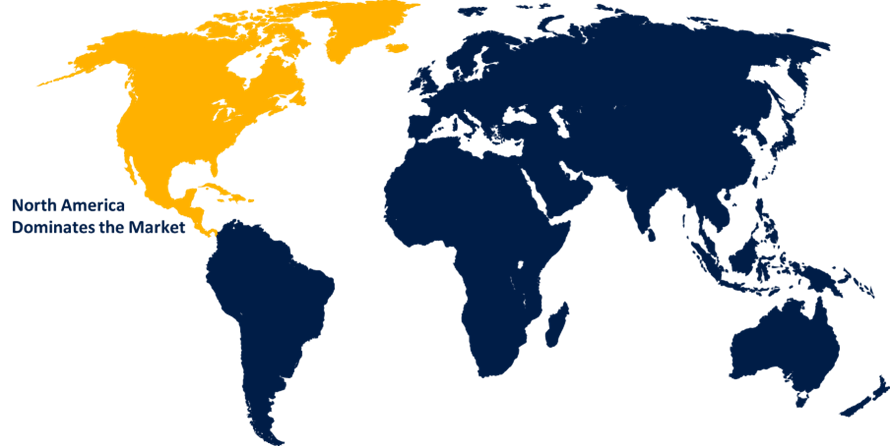Global Synthetic Aperture Radar Market Size To Grow USD 10.7 Billion By 2032 | CAGR of 10.9%
Category: Aerospace & DefenseGlobal Synthetic Aperture Radar (SAR) Market Size to Grow USD 10.7 Billion by 2032
According to a research report published by Spherical Insights & Consulting, the Global Synthetic Aperture Radar (SAR) Market Size is to grow from USD 3.8 Billion in 2022 to USD 10.7 Billion by 2032, at a Compound Annual Growth Rate (CAGR) of 10.9% during the forecast period.

Get more details on this report -
Browse key industry insights spread across 200 pages with 125 Market data tables and figures & charts from the report on "Global Synthetic Aperture Radar (SAR) Market Size, Share, and COVID-19 Impact Analysis, By Component (Receiver, Transmitter, and Antenna), By Platform (Airborne (Spacecraft, Aircraft and Unmanned Aerial Vehicle (UAV) and Ground), By Application (Military and Defense, Monitoring and Exploration), By Frequency Band (X, L, C, S, K/Ku/Ka, UHF/VHF), By Region (North America, Europe, Asia-Pacific, Latin America, Middle East, and Africa), Analysis and Forecast 2022– 2032" Get Detailed Report Description Here: https://www.sphericalinsights.com/reports/synthetic-aperture-radar-market
The phrase "synthetic aperture radar market" (SAR) refers to both ground- and space-based SAR that operates on the premise of transmitting and receiving reflected signals that interact with the ground to aid in imaging, tracking, detection, and characterization. Synthetic aperture radar has many more applications than conventional electro-optical (EO) imaging systems since microwaves can travel through clouds and provide dependable 24-hour, all-weather data efficiency. SAR systems are far less often used than traditional optical vision, although having several advantages. The Land Remote Sensing Policy Act of 1992's requirements for obtaining a license to use a private remote sensing space system was updated as a result of the publication of Licensing of Private Remote Sensing Space Systems by the Department of Commerce and the National Oceanic and Atmospheric Administration (NOAA).
Synthetic aperture radar is increasingly in demand from military applications since it may be used to locate missiles, complexes of buildings, and topographical features of the surrounding area on the surface. Synthetic aperture radar is also used to observe the battlefield, guide weapons, and plan missions for upcoming operations. The expansion of the military and defense budget allows for the creation of missiles with improved targeting precision. There are several significant ways that missile-borne SAR varies from airborne SAR, including high flight speed and straight movement, both of which are necessary for accurate real-time measurement. Furthermore, the cost of developing synthetic aperture radar is a key factor limiting the market's growth on a global scale. Large investments are required at many stages in the value chain for synthetic aperture radar. However, during the anticipated timeframe, difficulties with debris and deorbiting in space will be a significant barrier to the market for synthetic aperture radar.
Covid 19 Impact
Due to the COVID-19 issue, government limitations on public gatherings and announced lockdowns have slowed down R&D in SAR systems. Due to the COVID-19 impact, several countries' economies have shown signs of slowing down, which may hinder government expenditure on defense-related programs. The market for synthetic aperture radar will experience slower growth as a result of this decrease in expenditure. Because synthetic aperture radar is employed in a variety of military applications, COVID-19's travel limitations and reduction in military activity have also hurt industry growth. As industry production has started to pick up steam following the challenging COVID-19 period, there will be an increase in demand in the worldwide synthetic aperture radar market in the approaching quarter.
The antenna segment is influencing the largest market share during the forecast period.
The worldwide synthetic aperture radar market is divided into receiver, transmitter, and antenna segments based on the components. Among these sectors, the antenna segment is expected to dominate the market with the highest revenue share. The antenna is essential for sending and receiving radar signals. The SAR system can acquire data about the target region because it makes it easier for transmitted signals to be emitted and for reflected signals to be captured. Depending on the needs of the application, antennas can take a variety of shapes, including fixed and mobile ones.
The airborne segment is dominating the largest market growth over the forecast period.
The worldwide synthetic aperture radar market is divided into two sections based on platform: airborne (spacecraft, aircraft, and unmanned aerial vehicle (UAV)) and ground. The airborne category is outpacing the market in all of these categories. Unmanned aerial vehicles (UAVs) equipped with airborne synthetic aperture radars may easily collect data on terrains that are frequently changing, such as snow slopes and active volcanoes. Airborne synthetic aperture radar manufacturers are pursuing the development of specialized airborne synthetic aperture radars for unmanned aerial vehicles (UAVs).
The military and defense segment is leading the market with the largest market growth during the forecast period.
On the basis of applications, the synthetic aperture radar market is segmented into different segments such as military and defense, monitoring, and exploration. The military and defense sector, out of these categories, is expected to dominate the market throughout the projected period with the highest revenue share. A synthetic aperture radar is used in military applications to locate surface features such as apartment complexes, missile launchers, and topographical features in the region. To become ready for upcoming operations, it is employed for battlefield surveillance, weapon guidance, and mission planning. More precise missile targeting is made possible by rising military and defense spending.
North America leading the largest market share over the forecast period

Get more details on this report -
North America will be the largest market over the projection period, due to the tremendous rise in R&D activity for space-based SAR satellites as a consequence of cooperation between the US Department of Defense (DoD) and the National Aeronautics and Space Administration (NASA). Additionally, the country provides more than 40% of the global defense expenditure. These elements are projected to encourage business expansion in the area.
Major vendors in Global Synthetic Aperture Radar Market include Lockheed Martin Corporation, Airbus SE, Aselsan A.S., BAE Systems Plc, Cobham Plc (Advent), General Atomics Aeronautical Systems Inc., L3Harris Technologies, IMSAR LLC, Israel Aerospace Industries Ltd, Leonardo SpA, Maxar Technologies Ltd, MetaSensing Group, Northrop Grumman Corporation, Raytheon Company, Saab AB, SAR AERO, SRC Inc, Thales Group, & Others.
key Target Audience
- Market Players
- Investors
- End-users
- Government Authorities
- Consulting and Research Firm
- Venture capitalists
- Value-Added Resellers (VARs)
Recent Development
- In May 2022, in order to provide flood information to Copernicus Emergency Services, microsatellite maker ICEYE revealed a partnership with the European Space Agency. We will present critical ICEYE flood impact information that demonstrates the depth and breadth of the flood.
Market Segment
This study forecasts revenue at global, regional, and country levels from 2022 to 2032. Spherical Insights has segmented the Global Synthetic Aperture Radar Market based on the below mentioned segments:
Global Synthetic Aperture Radar Market, By Component
- By Component Receiver
- Transmitter
- Antenna
Global Synthetic Aperture Radar Market, By Platform
- Airborne
- Spacecraft
- Aircraft
- Unmanned Aerial Vehicle {UAV})
- Ground
Global Synthetic Aperture Radar Market, By Application
- Military and Defense
- Monitoring and Exploration
Global Synthetic Aperture Radar Market, By Frequency Band
- X
- L
- C
- S
- K/Ku/Ka
- UHF/VHF
Synthetic Aperture Radar Market, By Regional Analysis
- North America
- US
- Canada
- Mexico
- Europe
- Germany
- Uk
- France
- Italy
- Spain
- Russia
- Rest of Europe
- Asia Pacific
- China
- Japan
- India
- South Korea
- Australia
- Rest of Asia Pacific
- South America
- Brazil
- Argentina
- Rest of South America
- Middle East & Africa
- UAE
- Saudi Arabia
- Qatar
- South Africa
- Rest of the Middle East & Africa
About the Spherical Insights & Consulting
Spherical Insights & Consulting is a market research and consulting firm which provides actionable market research study, quantitative forecasting and trends analysis provides forward-looking insight especially designed for decision makers and aids ROI.
Which is catering to different industry such as financial sectors, industrial sectors, government organizations, universities, non-profits and corporations. The company's mission is to work with businesses to achieve business objectives and maintain strategic improvements.
CONTACT US:
For More Information on Your Target Market, Please Contact Us Below:
Phone: +1 303 800 4326 (the U.S.)
Phone: +91 90289 24100 (APAC)
Email: inquiry@sphericalinsights.com, sales@sphericalinsights.com
Contact Us: https://www.sphericalinsights.com/contact-us
Need help to buy this report?